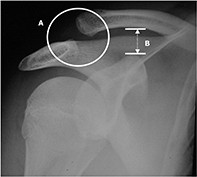Management of outer clavicle fractures and acromioclavicular joint dislocations
The function of the acromioclavicular joint is to anchor the scapula to the clavicle and, through this, suspend the shoulder girdle on the trunk. The main stabilisers of the acromioclavicular joint are the acromioclavicular and coracoacromial (conoid and trapezoid) ligaments (Figure 1). All these ligaments make the acromioclavicular joint very resilient so that it requires a significant amount of force to tear it apart. If there is a disruption of the ligaments or a fracture of the outer end of the clavicle then the scapula/ upper limb may sag inferiorly and alter the patterns of motion of the scapula against the thorax. Injuries in this region tend to arise from a fall onto the point of the shoulder or by an upward directed force along the arm.

